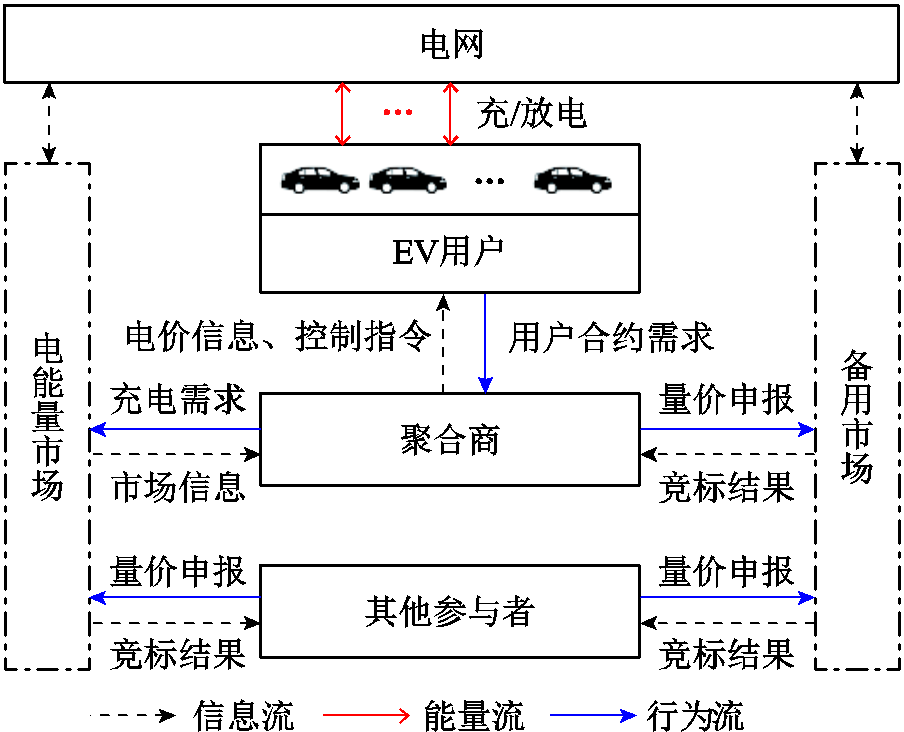
图1 EV与电网之间的交互关系
Fig.1 Interact among EVs and power grid
摘要 市场环境下,实现电动汽车(EV)的有序用电调度,将为电网提供多样化的功率调节手段,支撑“双碳”目标下新能源为主体新型电力系统的建设。其中涉及多方市场参与者的决策博弈,是能源的信息-物理-社会系统(CPSSE)的典型应用之一。EV聚合商作为连接EV用户与电网的中间环节,需要处理好与用户之间的合约博弈,以及做好电力市场中的决策策略。该文以EV集群提供运行备用为背景,首先,分析了多方市场参与者的交互关系,提出EV聚合商与用户之间的合约机制;然后,分析了EV集群同时参与电能量市场与备用市场的耦合效应,通过聚合商参与备用辅助服务市场的机制设计,实现了EV正常充电与参与备用服务的解耦;最后,以聚合商风险收益最大为目标,构建多场景下聚合商同时参与日前电能量市场与备用市场的联合调度优化模型,通过算例仿真揭示了模型的有效性,实现了日内备用调度不确定性时的日前最优风险预防控制。
关键词:电动汽车 备用 调度 市场机制 联合优化
中国提出了2030年前碳达峰、2060年前碳中和的目标。对于电力系统而言,构建以新能源为主体的新型电力系统是支撑“双碳”目标的重要举措。由于新能源出力具有本质上的难预测性,新能源高占比必然带来电力电量平衡的困难。运行备用的合理留取和调度是系统应对故障、平抑新能源出力波动、确保系统电力电量平衡的主要措施[1-2]。在电源侧脱碳进程中,风险源不断增加,而传统的调控资源池(如火电、水电等)却保持不变甚至不断缩小,系统充裕性的供需矛盾只会越来越突出,美国德州停电事故、东北拉限电事件便是例证。
备用问题具有多时间尺度特征[3-4],作为日前尺度的新型备用资源,电化学储能是未来提升系统充裕性、灵活性的重要手段[5-6],但集中式开发又面临高成本的困境。近年来,为了实现交通领域脱碳,电动汽车(Electric Vehicle, EV)的全球推广进展迅速,W.Kempton在1997年提出了V2G(vehicle to grid)的概念[7],将EV从一类可控负荷措施扩展为一类分布式电化学储能资源。为了分析需求侧参与备用的真实潜力,就必须考虑参与者的决策博弈行为,能源的信息-物理-社会系统(Cyber-Physical-Social System in Energy, CPSSE)[8]概念恰好顺应了这一研究趋势。它强调信息-物理系统(Cyber-Physical System, CPS)纳入社会元素的必要性,提出了基于混合仿真研究参与者决策行为的新范式[9],为“双碳”目标下的研究提供了路径优化的新框架[10-11]。
EV具有接入容量不确定、时空差异显著、状态聚类复杂等特性[12-13],调控不当容易造成局部高峰时段用电紧张[14]、局部配电网过负荷[15-16]、配电设备损耗加剧[17]等问题。当前EV研究主要聚焦于有序充电的运行规划[18-19],在确定性规划下提供的灵活性能力,以及提升配电网稳定性与运行效率的方法[20-21]。EV必须聚合为更大的集群才能参与批发性能量市场,文献[22]分析了现货市场环境下EV充换电站的优化调控问题;文献[23]设计了EV聚合商参与备用市场的机制,研究聚合商的策略优化问题。但鲜有研究EV电能量与辅助服务的耦合问题,缺少综合两者的市场机制研究。针对EV同时参与电能量市场与备用市场的优化问题,存在三种优化思路:单独排序优化、顺序优化与联合优化[24]。其中,单独排序优化忽视了电量与备用的耦合,可能导致出清结果违反机组容量等物理约束;顺序优化满足了机组容量约束,但会导致市场出清的总成本偏高;联合优化满足了机组容量约束,并且市场总成本最低,但需解决优化模型的复杂性难题。
本文基于EV短时备用容量的量化[25-26]与经济性评价[27]方面的已有成果,针对不确定调度情况下EV在电能量市场与辅助服务市场的耦合问题,首先构建了EV与电网交互研究的整体架构,分析影响聚合商收益的相关市场环节;然后,分析EV在电能量市场与备用市场的耦合效应,从优化模型与预防控制中提出解决方案;接着,在备用市场中考虑确定性的备用容量与不确定性的备用电量(EV提供备用时被实际调度的电量),以聚合商收益最大化为目标,构建EV聚合商同时参与电能量市场与备用市场的联合调度优化模型;最后,通过算例分析验证了模型的有效性,实现多方市场参与者的共赢。
EV与电网之间的交互关系如图1所示。与EV有关的市场包括碳市场、电能量市场及备用辅助服务市场;参与者包括EV用户、EV聚合商及其他参与者。聚合商需要考虑与EV用户之间的合约博弈,以及与其他参与者之间的市场竞标博弈:在合约博弈中,聚合商与用户签订充电合约,有条件地购得调度权;聚合商通过给予用户电价折扣等合约套餐,吸引用户参与有序充/放电。在竞标博弈中,聚合商需在遵守合约的基础上与发电、储能、可控负荷等其他参与者竞争,购入低价电量并且售出灵活性容量。

图1 EV与电网之间的交互关系
Fig.1 Interact among EVs and power grid
该架构体现了信息、物理、社会元素的融合:EV用户的决策意愿通过选取合约套餐体现,聚合商的决策意愿通过合约套餐发布、市场竞标策略及对充放电策略的优化集中体现。
聚合商通过给予用户一定的充电电价折扣,吸引用户参与有序充/放电。充/放电合约需满足用户的各类出行需求,其中包括不确定性出行需求。因此,约定EV电量需始终大于保底电量Ems,以保障用户的不定时用车需求。不同充电初始状态下EV的充/放电可行域如图2所示。图2中tstart、tms、tend分别为充电开始时刻(EV入网时刻)、充电至保底电量的时刻、充电结束时刻(EV离网时刻);Eexp、Emax分别为离网时用户的期望电量、EV的电池容量。
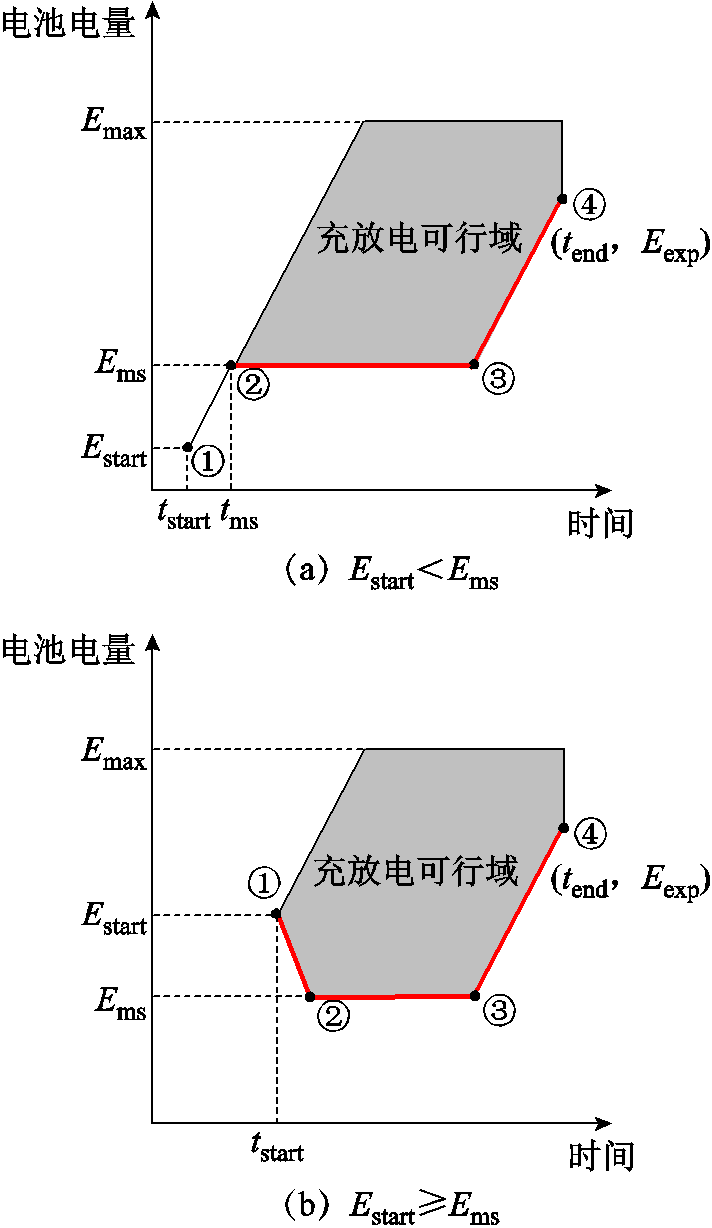
图2 不同充电初始状态下EV的充/放电可行域
Fig.2 Charge/discharge feasible zone of EVs with diverse initial states of charge
根据接入电网时起始电量Estart的不同,EV的充/放电调度可分两种情况考虑:当Estart<Ems时,立即以最大充电功率充电至保底电量(如图2a中①~②);当Estart≥Ems 时,可直接启用给定的有序充/放电调度策略。
考虑到在计划的充电结束时间内需达到或超过期望电量(图2中状态④),EV有序充/放电策略输出在“时间-电量”平面上留下的路径只能处于图2阴影区域所示的“充/放电可行域”内,可行域下边缘的红色粗线为充/放电过程中的最低电量约束线。显然,可行域内有任意多条路径可选,可行域受合约确定的参数值约束。
因此,EV用户与聚合商之间的充电合约至少包括以下定价要素:入网时间、离网时间、起始电量、保底电量、期望电量、充电价格、可接受的最大放电次数等。EV入网时,聚合商给出不同定价要素参数值对应的充电电价打折系数,也即用户可参与的有序充/放电合约套餐种类,引导用户的合约决策;用户比较哪种合约套餐满足期望的打折系数,提交用车需求信息(即设置各项定价要素对应的参数值)。
2.2.1 市场时间尺度
EV的备用能力按调节方向可分为上备用能力(向电网反向放电或降低充电功率)和下备用能力(降低放电功率或增加充电功率)两类。现有备用辅助服务市场主要以火电等传统发电机组为参与主体,EV的可调控能力相对传统机组来说更为有限,主要体现在提供备用的持续时间较短。市场设计的时间尺度决定了备用容量被调用的最短持续时间,时间尺度越小EV集群可申报的备用容量越大,越小时间尺度的备用市场越能发挥EV的潜在价值[25]。
图3反映了备用市场中一个调度周期T(一般为24 h)与市场时间尺度∆t的关系。EV在日前备用市场的申报量为一个调度周期T内各∆t可提供的备用容量,参与备用市场的收益包括备用容量费与备用容量被实际调用时的备用电量费。在市场时间尺度与调度规则限定下,EV在一个∆t时段内申报的备用容量为恒定值,且一个调度周期内支持任意一个或多个时段发生备用容量的调用。
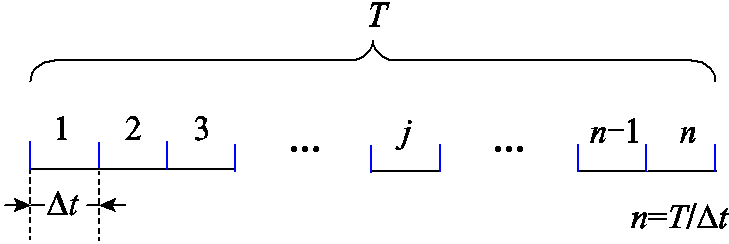
图3 调度周期与市场时间尺度的关系
Fig.3 The relationship between dispatch period and market time-scale
2.2.2 两类耦合效应及其解耦
EV的备用容量与当前充/放电功率、当前荷电量状态(State of Charge, SOC)等时变因素有关,因此EV的备用容量也呈现出时变特征。所以,当EV提供的备用容量被实际调用时,一方面将影响后续时段在日前申报的备用容量计划(备用电量与备用容量的耦合,称为第一类耦合效应);另一方面,由于备用电量本质上也是电量的交换,这同样会影响EV的充/放电计划(备用电量与现货电量的耦合,称为第二类耦合效应)。
针对第一类耦合效应造成的备用容量时变问题,虽然从技术层面可以实现不同时段备用容量的快速计算,但无法解决后续时段备用容量与日前申报量不匹配的问题。在典型的多场景优化过程中,控制策略的选取应根据事件的风险性质来区分。因此,对于EV集群参与备用的优化调度,利用多场景的风险优化,进行备用缺额事件发生前的预防控制,可对可能发生的备用缺额事件进行有效防控,以此消除第一类耦合效应的影响。
对于第二类耦合效应,将被实际调用的备用电量纳入电能量市场体系中,但在结算时予以区分。EV备用容量同时受可充/放的电量与功率的制约[25],图4以时段k某单体EV电池容量与SOC充足背景下的充电状态作为示例,其中,PL.max、PG.max分别为最大充电功率和最大放电功率,Pcd.max(k)、Pcu.max(k)分别为最大下备用容量和最大上备用容量,P(k)为计划充电功率,Pd(k)为下备用容量被实际调用的部分。P(k)叠加Pd(k)构成了运行中的实际充电功率,在结算时两者均需支付电能量市场的电量费,此外Pd(k)部分还应获得备用电量费。

图4 EV单体在时段k参与电能量市场与备用市场情况
Fig.4 The power energy and reserve capacity of an EV in the kth period
备用容量是EV的潜在能力,聚合商参与日前备用市场时需要申报未来一日内所有时段的竞标量。由于备用容量被调用是随机性事件(可能在日内任意时段发生),以及第一类耦合效应的存在,导致其备用容量的日前申报量无法直接采用日内实际充/放电功率曲线进行解析。因此,采用EV的日前计划功率Pwait用于解析EV日前可申报的备用容量,Pwait为日前待执行的计划功率,EV的日前计划功率与日内实际功率如图5所示。Pwait与日内实际功率曲线P存在差异的时段(如图5中时段tm、tn所示)即说明日内备用容量发生了调用,如果日内无备用容量发生调用则Pwait与P重合。需要指出的是,即使日内备用缺额事件是不确定的(存在多种可能性),但对于EV聚合商来说日前预申报的备用容量曲线仍是确定性的(唯一的)。

图5 EV的日前计划功率与日内实际功率
Fig.5 The planned power in day-ahead market and the real power within-day of EV
在厘清EV与电网的交互关系,明确用户与聚合商的合约机制及备用市场机制后,以聚合商的收益最大化为目标,构建多场景下(不同备用缺额事件)EV集群同时参与日前电能量市场与备用市场的联合调度优化模型。其中,电能量市场和备用市场中同时兼顾确定性的备用容量、发电(用户充电)与用电,以及不确定性的备用电量,即
 (1)
(1)
式中,G为聚合商的总收益;ρs为场景s发生的概率;N为EV的总数量;Mi为第i辆EV提供备用时聚合商的净收益;πi为参与备用市场的备用收益,πi=πi.cu+πi.cd+πi.eu+πi.ed,πi.cu为上备用容量收益,πi.cd为下备用容量收益,πi.eu为上备用电量收益,πi.ed为下备用电量收益;bi.grid为聚合商参与电能量市场的电量费支出,即聚合商支付给电网的充电费用;bi.user为聚合商从用户处收取的充电费用;wi为聚合商获得的环保补贴、碳减排等收益;fi.user为用户违约的惩罚;fi.agr为聚合商违约的惩罚。
统一按市场时间尺度对时间轴离散化,即将一个调度周期T分割为n个长度为∆t的时段,冻结∆t内EV功率的时变性,则式(1)可分解为式(2),其中决策变量为各EV的日前计划功率Pi.wait。

结合2.2节中耦合效应的解耦方案,则有
 (3)
(3)
 (4)
(4)
 (5)
(5)
 (6)
(6)
 (7)
(7)
 (8)
(8)
 (9)
(9)
式中,vi(k)为第k个时段EV是否接入电网的(0-1)整数变量,1表示在线,0表示离线;φi.eu、φi.ed分别为上、下备用容量是否发生调用的(0-1)整数变量,1表示发生调用,0表示未发生调用;Pi.cu、Pi.cd分别为上、下备用容量;Pi.eu、Pi.ed分别为上、下备用电量;λcu、λcd分别为上、下备用容量价格;λeu、λed分别为上、下备用电量价格;λe为电量价格;Pi为EV日内的实时充/放电功率,式(8)表示Pi.wait叠加日内被实际调度的备用容量构成EV日内的实时充/放电功率;αi.user为用户充电费用的折扣系数;Pi.user为用户与集电商签约前的自主充电功率,本文中为不考虑备用收益时充电费用最小的充电策略,即以式(10)为目标优化求取的充电功率最优解。
 (10)
(10)
1)备用调度约束
同一个时段内无法同时调度上备用容量与下备用容量,其约束条件为
 (11)
(11)
2)充/放电功率约束
EV同时参与电能量市场与备用市场时,其充/放电功率约束将分为三种情况。
(1)在电能量市场与备用市场均支持放电,充/放电功率约束为
 (12)
(12)
(2)在电能量市场与备用市场均不支持放电,充/放电功率约束为
 (13)
(13)
(3)在电能量市场时不支持放电,仅在备用市场中支持放电,充/放电功率约束为
 (14)
(14)
3)电池容量约束
 (15)
(15)
 (16)
(16)
式中,Ei(k)为EV单体的实时电量是关于Pi( j)的时变函数;Ei.max为EV单体电池容量。
4)用户充电需求约束
按照EV用户与聚合商的有序充/放电合约,聚合商需要兼顾用户的不确定性用车需求,并在用户离网前满足期望的电量,因此用户的充电需求约束为
Ei.start<Ei.ms时
 (17)
(17)
 (18)
(18)
Ei.start≥Ei.ms时
 (19)
(19)
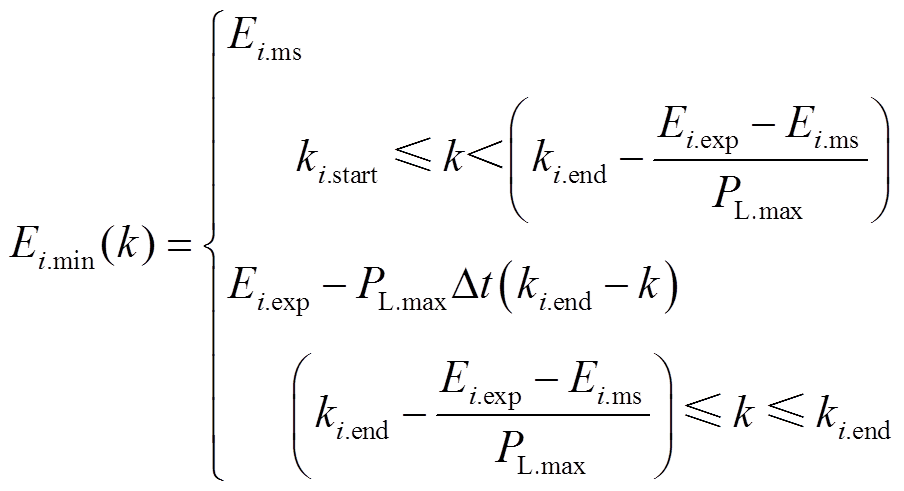 (20)
(20)
式中,Ei.min为第i辆EV的最低电量约束,如图2中红色粗实线所示。
5)备用容量约束
EV单体的上、下备用能力可按式(21)、式(22)计算[25]。在式(21)中PG.max+Pi.wait(k)为功率边界的影响;Ei(k)–Ei.min(k+1)为第k个时段内的最大可放电量,[Ei(k)–Ei.min(k+1)]/∆t+Pi.wait(k)则为预想工况下EV的可放电量潜力,反映出电量边界的影响。在式(22)中PL.max−Pi.wait(k)为功率边界的影响;Ei.max–Ei(k)为第k个时段内的最大可充电量,[Ei.max–Ei(k)]/∆t−Pi.wait(k)则为预想工况下EV的可充电量潜力。
 (21)
(21)
 (22)
(22)
式中,Pi.cu.max(k)和Pi.cd.max(k)分别为第k个时段EV单体上备用容量和下备用容量的最大值;Ei.min(k)为第k个时段起始点电池的最低电量约束。
因此,EV的上、下备用容量约束为
 (23)
(23)
 (24)
(24)
6)备用电量约束
对于备用容量发生调用的时段,其备用电量约束为
 (25)
(25)
 (26)
(26)
仿真中EV的数量设置为200,EV单体的仿真参数见表1;不失一般性,算例中λe取PJM现货市场的实时电价(2021年7月22日12:00—7月23日12:00,如图6所示);备用容量和备用电量的价格与发生备用缺额的场景关系密切,此处算例仅用于说明不同备用缺额场景的差异,所以不妨设置λcu = λcd= 10%λe,λeu = λed= λe。
表1 EV单体仿真参数
Tab.1 Simulation parameters of an individual EV

参数数值 Emax/(kW·h)50 Ems50%Emax Eexp95%Emax PL.max/kW6 PG.max/kW6 ∆t/h1
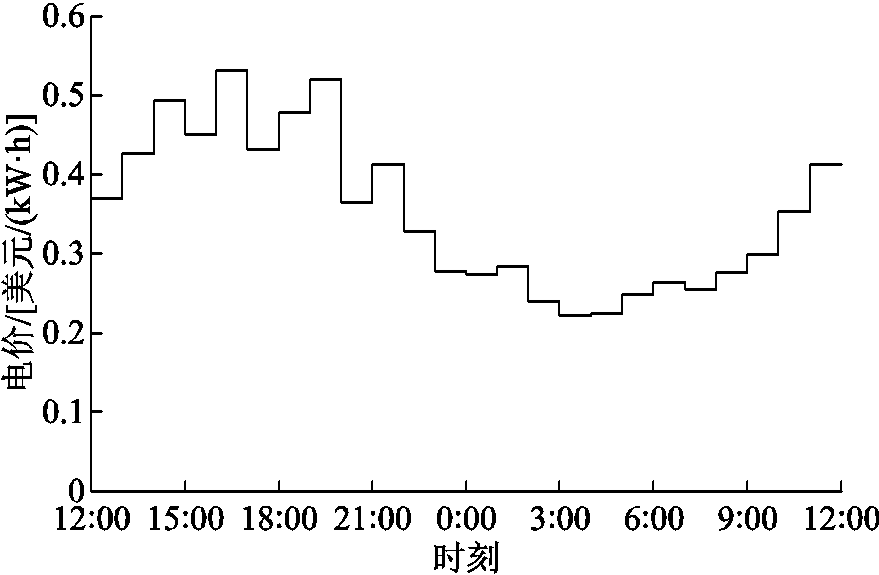
图6 某调度周期电能量市场的电价
Fig.6 Electricity price in electricity energy market
用户每天最后一次出行结束时间的概率密度满足正态分布[26],将最后一次出行的结束时间作为EV入网的开始时间;充电时长设为12 h;充电起始的SOC服从[20%,80%]的均匀分布。用户参与受控充电合约的意愿可通过问卷调查建立起较准确的模型[28]。为考察EV提供运行备用的作用及效果,假设集群中用户均有参与受控充/放电的意愿,且用户期望的打折系数服从[0.2 , 0.8]的均匀分布;设定聚合商与EV用户的签约原则为式(1)中(max Mi)>0。
考虑到频繁放电对电池寿命的影响[29],由于电能量市场中放电为高频事件,而备用容量发生调用为低频事件,因此算例仿真中以EV在电能量市场时不参与放电,仅在备用市场中参与放电为例。所以,充/放电功率约束设定为式(14)。
采用YALMIP工具包进行仿真运算。忽略环保补贴与碳减排收益,在上述参数下所有200辆EV用户自主充电时的电费支出为1 212.23 $(此时聚合商的收益为0)。以下根据备用缺额事件的发生场景(见表2),结合算例具体分析聚合商的最大收益与EV集群在日前备用市场的申报量,算例编号与事件场景的关系见表3。
表2 备用缺额事件场景
Tab.2 The scenarios of reserve shortage event

场景编号备用缺额事件 A未发生备用缺额 B21:00—22:00发生上备用缺额 C21:00—22:00发生下备用缺额 D次日7:00—8:00发生上备用缺额 E21:00—22:00与次日7:00—8:00均发生上备用缺额
表3 算例编号与备用缺额事件场景的对应关系
Tab.3 The corresponding relation between the cases and scenarios

算例编号对应场景 1场景A发生概率为1 2场景B发生概率为1 3场景C发生概率为1 4场景E发生概率为1 5场景B发生概率为0.5,场景D发生概率为0.5
4.2.1 未发生备用缺额事件
所有算例中用户的充电费用与聚合商的收益见表4。其中,算例1中未发生备用缺额事件,用户签约后的总充电费用下降至995.23 $,其中聚合商选择签约的用户占58.5%。聚合商的最大收益max G为217.20 $,其中备用市场收益仅为日前提供1 h备用的容量收益,对应的EV集群充/放电功率与日前申报的1h上、下备用容量如图7所示。由于未发生备用缺额事件,日前计划功率曲线与充/放电功率曲线重合。
表4 各算例中用户的充电份费用与聚合商的收益(算例0表示用户与聚合商未签约)
Tab.4 Charge cost of EV users and revenue of aggregator in each case (Case 0 means there is no contract between user and aggregator)

算例编号用户充电成本/$聚合商收益/$ 01 212.230 1995.23217.20 2647.64 3532.46 4767.91 5261.51

图7 未发生备用缺额事件时EV集群的充/放电功率和上、下备用容量
Fig.7 Charge/discharge power, upward and downward reserve capacity of EV cluster without reserve shortage event
4.2.2 单一时段发生备用缺额事件
1)场景B发生概率为1
算例2中场景B的发生概率为1。该算例下,21:00—22:00时段EV的上备用容量发生调用。由于在备用市场额外获得了备用电量收益,此时聚合商的收益增至647.64 $。对应的EV集群充/放电功率与日前申报的1 h上、下备用容量如图8所示。虽然21:00—22:00时段EV集群的备用容量发生调用,但后续时段EV集群仍具备提供上、下备用容量的能力,可随时调度。
2)场景C发生概率为1
算例3中场景C发生的概率为1。该算例下,21:00—22:00时段EV的下备用容量发生调用。调用后此时段的充电负荷显著增加,此时聚合商的收益为532.46 $,对应的EV集群充/放电功率与日前申报的1 h上、下备用容量如图9所示。同理,时段21:00—22:00后续时段EV集群仍具备提供上、下备用容量的能力。
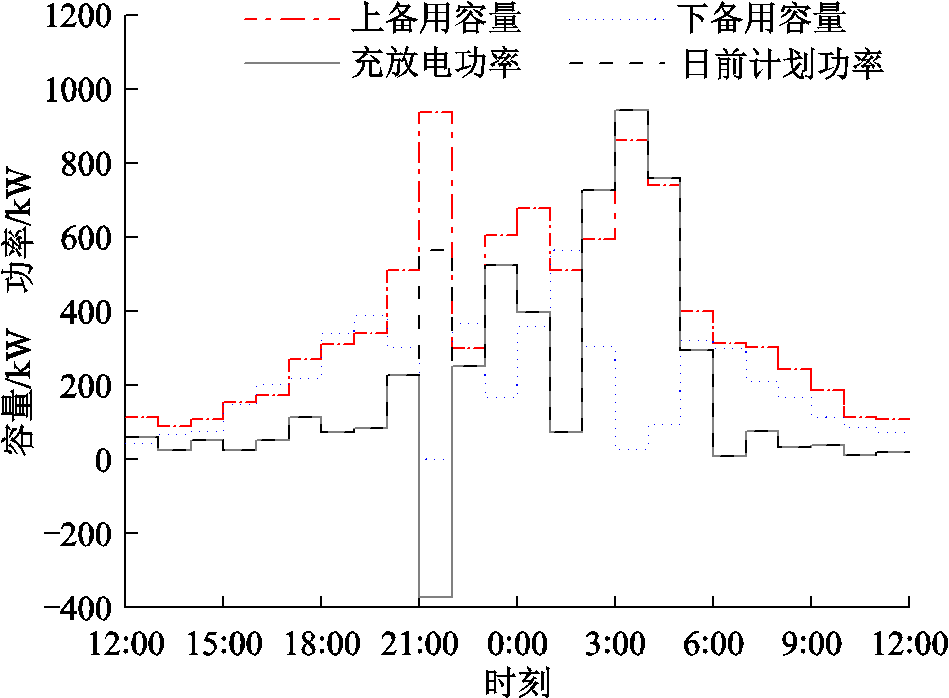
图8 场景B下EV集群的充/放电功率和上、下备用容量
Fig.8 Charge/discharge power, upward and downward reserve capacity of EV cluster in scenario B
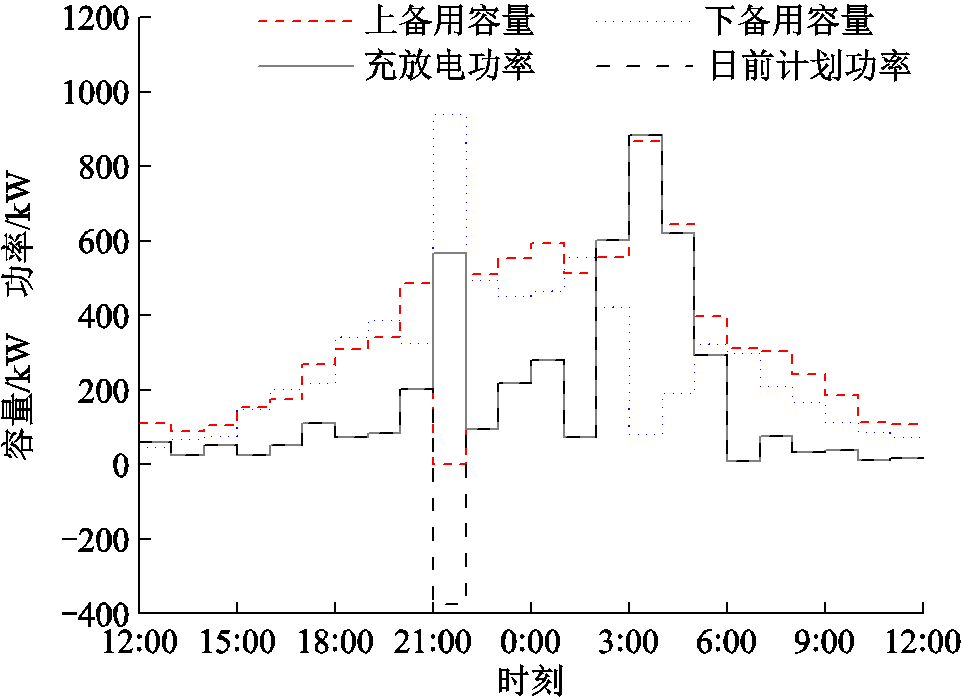
图9 场景C下EV集群的充/放电功率和上、下备用容量
Fig.9 Charge/discharge power, upward and downward reserve capacity of EV cluster in scenario C
3)不同时段发生备用缺额事件
在单一时段发生备用缺额事件的场景下,图10为各时段分别发生备用缺额事件时聚合商收益的仿真结果。由仿真结果易知,由于备用电量收益的存在,聚合商的收益均有不同程度的提高。
4)各场景不同发生概率的灵敏度分析
以[0, 1]为区间,按0.1为步长分别逐步摄动场景B、C、D的发生概率,此时聚合商风险收益的变化如图11所示。从仿真结果发现,随着场景发生的确定性提高(概率越高),聚合商制定充/放电策略及在备用市场中可投标量的确定性就越高,其收益也就越高。

图10 不同时段发生备用缺额事件时聚合商的收益
Fig.10 Aggregator’s revenue when reserve capacity was dispatched at different times
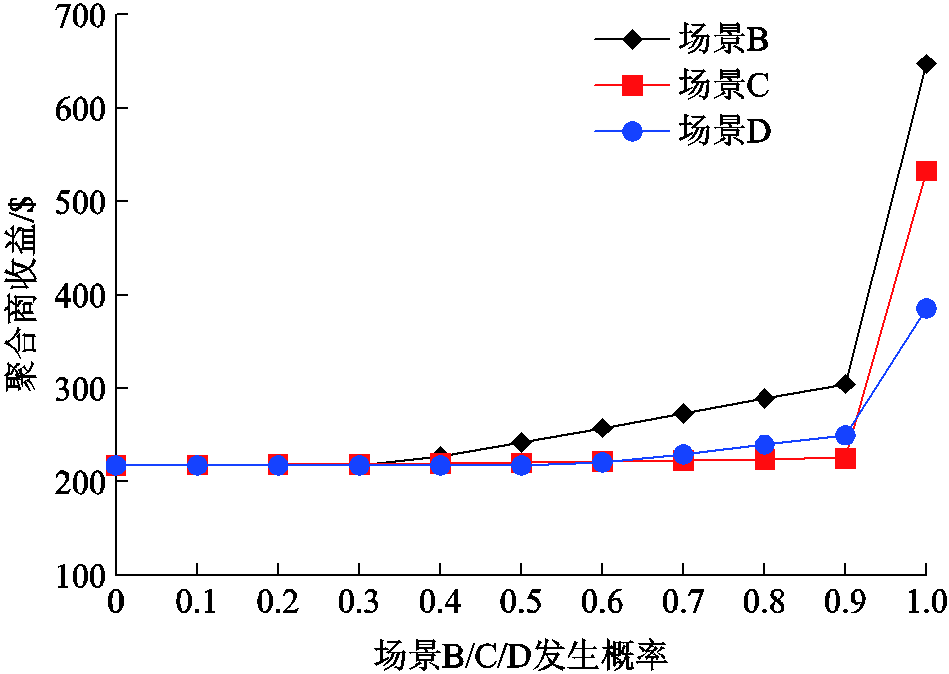
图11 场景B/C/D不同发生概率时聚合商的收益
Fig.11 Aggregator’s revenue with different occurrence probabilities of scenario B/C/D
4.2.3 多个时段发生备用缺额事件
算例4中场景E的发生概率为1。该算例下,21:00—22:00与次日7:00—8:00两个时段EV的上备用容量均发生调用。由于备用容量被调度的时段增加,此时聚合商的收益增加至767.91 $,对应的EV集群充/放电功率与日前申报的1 h上、下备用容量如图12所示。
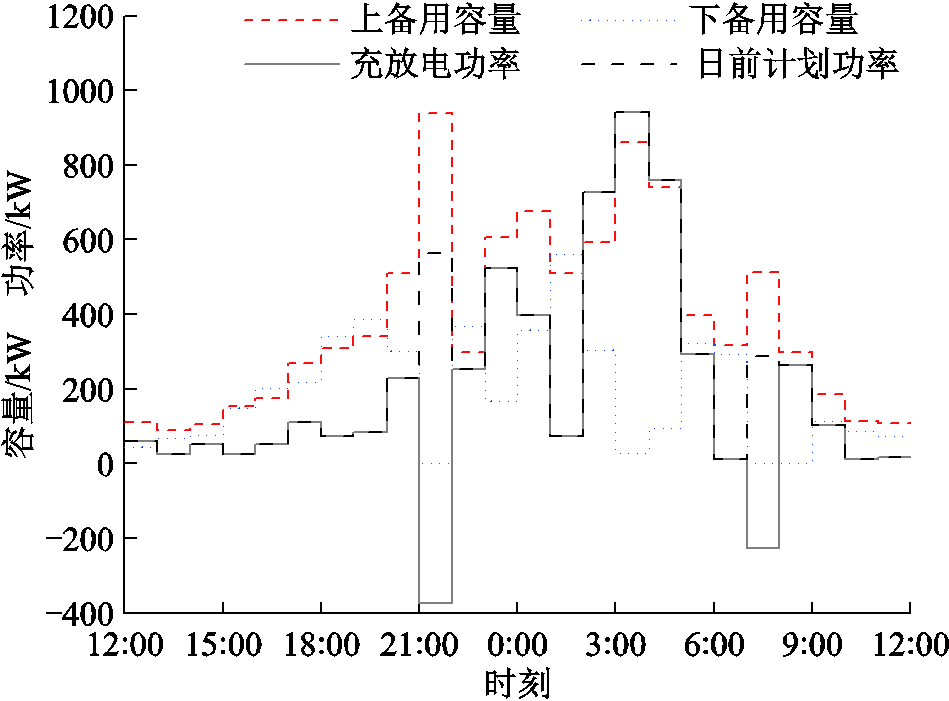
图12 场景E下EV集群的充/放电功率和上、下备用容量
Fig.12 Charge/discharge power, upward and downward reserve capacity of EV cluster in scenario E
4.2.4 发生多个备用缺额事件
算例5中场景B的发生概率为0.5,场景D的发生概率为0.5。此算例下,备用缺额事件的发生为概率性事件,制定充/放电计划应充分考虑不同场景发生的可能性(EV集群的最优充/放电功率与日前申报的1 h上、下备用容量如图13所示)。相比算例2(场景B的发生概率为1),由于发生备用缺额事件不确定性的提高,此时聚合商的风险收益由647.64 $降低为261.51 $。
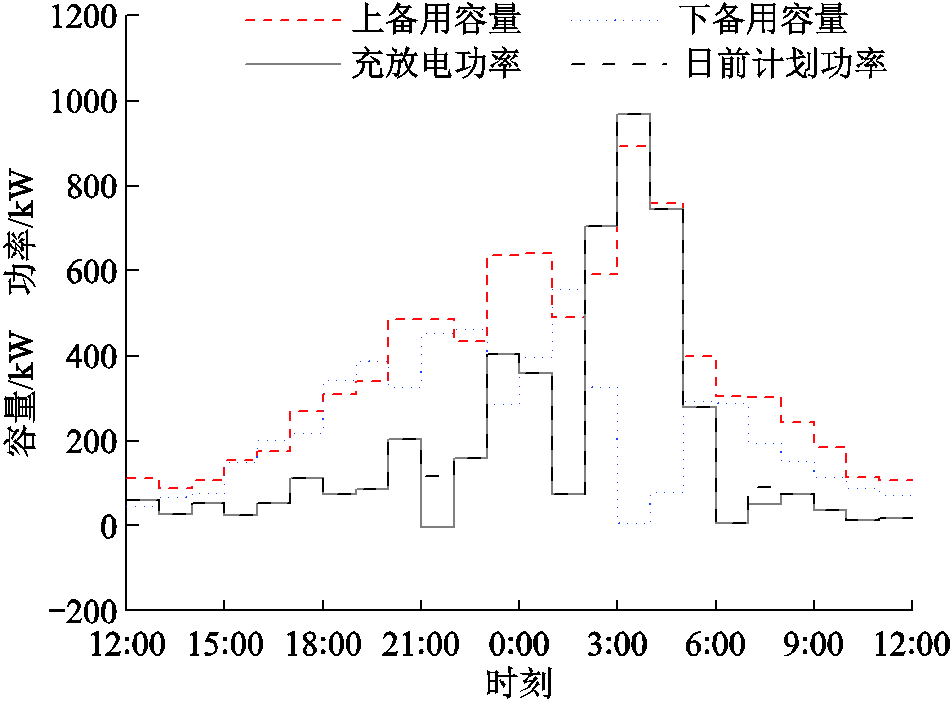
图13 发生多个备用缺额事件时EV集群的充/放电功率和上、下备用容量
Fig.13 Charge/discharge power, upward and downward reserve capacity of EV cluster in multiple scenarios
聚合商管理下的EV集群是潜力巨大的需求侧分布式储能资源,引导其参与电网备用辅助服务,是构建新能源为主体新型电力系统的有效技术路径。市场环境下,实现EV与电网友好互动的框架,经济上需要解决EV用户、聚合商、电网三方之间的利益博弈,技术上需要协调EV在多个市场之间的交互耦合。
本文基于“解耦协调”的思路,以风险收益最大为目标,提出聚合商在不同市场(电能量市场与备用市场)调度策略的联合优化模型。算例分析表明,本文所提模型和策略一方面从理论上验证了EV同时参与两个市场的可行性,实现了聚合商日前最优风险预防控制,同时也促进了多方市场参与者的共赢。下一步的研究方向包括聚合商同时参与日前、实时多尺度备用市场的策略,以及EV参与电网全过程(包含充裕性预防控制与紧急控制过程)后的风险成本量化评估等。
致 谢
本文算例的仿真实施得到邓诗扬、朱元梦两位学生的协助,特此感谢!
参考文献
[1] 王建学, 王锡凡, 别朝红. 电力市场中的备用问题[J]. 电力系统自动化, 2001, 25(15): 7-11, 14. Wang Jianxue, Wang Xifan, Bie Zhaohong. Reserve in the power market[J]. Automation of Electric Power Systems, 2001, 25(15): 7-11, 14.
[2] 张尧翔, 刘文颖, 庞清仑, 等. 高比例风电接入系统光热发电-火电旋转备用优化方法[J]. 电工技术学报, 2022, 37(21): 5478-5489. Zhang Yaoxiang, Liu Wenying, Pang Qinglun, et al. Optimal power spinning reserve method of concentrating solar power and thermal power for high-proportion wind power system[J]. Transactions of China Electrotechnical Society, 2022, 37(21): 5478-5489.
[3] 亢丽君, 王蓓蓓, 薛必克, 等. 计及爬坡场景覆盖的高比例新能源电网平衡策略研究[J]. 电工技术学报, 2022, 37(13): 3275-3288. Kang Lijun, Wang Beibei, Xue Bike, et al. Research on the balance strategy for power grid with high proportion renewable energy considering the ramping scenario coverage[J]. Transactions of China Electrotechnical Society, 2022, 37(13): 3275-3288.
[4] 吴俊, 薛禹胜, 舒印彪, 等. 大规模可再生能源接入下的电力系统充裕性优化(一)旋转级备用的优化[J]. 电力系统自动化, 2019, 43(8): 101-109. Wu Jun, Xue Yusheng, Shu Yinbiao, et al. Adequacy optimization for a large-scale renewable energy integrated power system part one spinning-grade reserve optimization[J]. Automation of Electric Power Systems, 2019, 43(8): 101-109.
[5] 吴珊, 边晓燕, 张菁娴, 等. 面向新型电力系统灵活性提升的国内外辅助服务市场研究综述[J]. 电工技术学报, 2023, 38(6): 1662-1677. Wu Shan, Bian Xiaoyan, Zhang Jingxian, et al. A review of domestic and foreign ancillary services market for improving flexibility of new power system[J]. Transactions of China Electrotechnical Society, 2023, 38(6): 1662-1677.
[6] 张靖, 张志文, 胡斯佳, 等. 独立微电网风储协同调频的功率柔性分配策略[J]. 电工技术学报, 2022, 37(15): 3767-3780. Zhang Jing, Zhang Zhiwen, Hu Sijia, et al. A flexible power distribution strategy with wind turbine generator and energy storage for frequency regulation in isolated microgrid[J]. Transactions of China Electrotechnical Society, 2022, 37(15): 3767-3780.
[7] Kempton W, Letendre S E. Electric vehicles as a new power source for electric utilities[J]. Transportation Research Part D: Transport and Environment, 1997, 2(3): 157-175.
[8] Xue Yusheng, Yu Xinghuo. Beyond smart grid—cyber–physical–social system in energy future[point of view[J]. Proceedings of the IEEE, 2017, 105(12): 2290-2292.
[9] Xue Yusheng, Wu Juai, Xie Dongliang, et al. Multi-agents modelling of EV purchase willingness based on questionnaires[J]. Journal of Modern Power Systems and Clean Energy, 2015, 3(2): 149-159.
[10] 薛禹胜. 新型电力系统通过CPSSE主动支撑中国的双碳目标[EB/OL]. 《电力系统自动化》微信公众号, 2021-08-16, https://mp.weixin.qq.com/s/ z_hH6HUI40jnaBNqpXjXaQ. Xue Yusheng. The new-type power system supporting the dual carbon target of China via CPSSE [EB/OL]. WeChat Official Account of Automation of Electric Power Systems, 2021-08-16, https://mp.weixin.qq. com/s/z_hH6HUI40jnaBNqpXjXaQ.
[11] 冷俊, 薛禹胜. “双碳”目标下,新型电力系统发展路径的优化思路[J]. 中国电力企业管理, 2021(19): 11-13. Leng Jun, Xue Yusheng. Optimization of the development path of new power system under the goal of “double carbon”[J]. China Power Enterprise Management, 2021(19): 11-13.
[12] Daina N, Sivakumar A, Polak J W. Electric vehicle charging choices: modelling and implications for smart charging services[J]. Transportation Research Part C: Emerging Technologies, 2017, 81: 36-56.
[13] 师瑞峰, 李少鹏. 电动汽车V2G问题研究综述[J]. 电力系统及其自动化学报, 2019, 31(6): 28-37. Shi Ruifeng, Li Shaopeng. Review on studies of V2G problem in electric vehicles[J]. Proceedings of the CSU-EPSA, 2019, 31(6): 28-37.
[14] Boßmann T, Staffell I. The shape of future electricity demand: exploring load curves in 2050s Germany and Britain[J]. Energy, 2015, 90: 1317-1333.
[15] Ahmad M S, Sivasubramani S. Optimal number of electric vehicles for existing networks considering economic and emission dispatch[J]. IEEE Transactions on Industrial Informatics, 2019, 15(4): 1926-1935.
[16] Awadallah M A, Singh B N, Venkatesh B. Impact of EV charger load on distribution network capacity: a case study in Toronto[J]. Canadian Journal of Electrical and Computer Engineering, 2016, 39(4): 268-273.
[17] Muratori M. Impact of uncoordinated plug-in electric vehicle charging on residential power demand[J]. Nature Energy, 2018, 3(3): 193-201.
[18] 何晨可, 朱继忠, 刘云, 等. 计及碳减排的电动汽车充换储一体站与主动配电网协调规划[J]. 电工技术学报, 2022, 37(1): 92-111. He Chenke, Zhu Jizhong, Liu Yun, et al. Coordinated planning of electric vehicle charging-swapping-storage integrated station and active distribution network considering carbon reduction[J]. Transactions of China Electrotechnical Society, 2022, 37(1): 92-111.
[19] 李长云, 徐敏灵, 蔡淑媛. 计及电动汽车违约不确定性的微电网两段式优化调度策略[J]. 电工技术学报, 2023, 38(7): 1838-1851. Li Changyun, Xu Minling, Cai Shuyuan. Two-stage optimal scheduling strategy for micro-grid considering EV default uncertainty[J]. Transactions of China Electrotechnical Society, 2023, 38(7): 1838-1851h
[20] 陈嘉鹏, 汤乃云, 王雪松. 基于电动汽车入网特性的电网经济调度研究[J]. 电气技术, 2019, 20(3): 24-30, 36. Chen Jiapeng, Tang Naiyun, Wang Xuesong. Research on economic dispatch of power grid based on vehicle to grid characteristics of electric vehicle[J]. Electrical Engineering, 2019, 20(3): 24-30, 36.
[21] 胡俊杰, 周华嫣然, 李阳. 集群电动汽车平抑光伏波动实时调度策略[J]. 电网技术, 2019, 43(7): 2552-2560. Hu Junjie, Zhou Huayanran, Li Yang. Real-time dispatching strategy for aggregated electric vehicles to smooth power fluctuation of photovoltaics[J]. Power System Technology, 2019, 43(7): 2552-2560.
[22] 曾宪锴, 杨苹, 刘璐瑶, 等. 电力现货市场环境下电动汽车充换电站的优化调控策略[J]. 电力自动化设备, 2022, 42(10): 38-45. Zeng Xiankai, Yang Ping, Liu Luyao, et al. Optimal regulation strategy of battery charging and swapping station for electric vehicles under electricity spot market environment[J]. Electric Power Automation Equipment, 2022, 42(10): 38-45.
[23] Hu Junjie, Yang Guangya, Ziras C, et al. Aggregator operation in the balancing market through network-constrained transactive energy[J]. IEEE Transactions on Power Systems, 2019, 34(5): 4071-4080.
[24] 石剑涛, 郭烨, 孙宏斌, 等. 备用市场机制研究与实践综述[J]. 中国电机工程学报, 2021, 41(1): 123-134, 403. Shi Jiantao, Guo Ye, Sun Hongbin, et al. Review of research and practice on reserve market[J]. Proceedings of the CSEE, 2021, 41(1): 123-134, 403.
[25] 吴巨爱, 薛禹胜, 谢东亮, 等. 电动汽车参与运行备用的能力评估及其仿真分析[J]. 电力系统自动化, 2018, 42(13): 101-107, 168. Wu Juai, Xue Yusheng, Xie Dongliang, et al. Evaluation and simulation analysis of reserve capability for electric vehicles[J]. Automation of Electric Power Systems, 2018, 42(13): 101-107, 168.
[26] 吴巨爱, 薛禹胜, 谢东亮. 电动汽车聚合商对备用服务能力的优化[J]. 电力系统自动化, 2019, 43(9): 75-81. Wu Juai, Xue Yusheng, Xie Dongliang. Optimization of reserve service capability made by electric vehicle aggregator[J]. Automation of Electric Power Systems, 2019, 43(9): 75-81.
[27] 陆凌蓉, 文福拴, 薛禹胜, 等. 电动汽车提供辅助服务的经济性分析[J]. 电力系统自动化, 2013, 37(14): 43-49, 58. Lu Lingrong, Wen Fushuan, Xue Yusheng, et al. Economic analysis of ancillary service provision by plug-in electric vehicles[J]. Automation of Electric Power Systems, 2013, 37(14): 43-49, 58.
[28] Wu Juai, Xue Yusheng, Xie Dongliang, et al. Multi-agent modeling and analysis of EV users’ travel willingness based on an integrated causal/ statistical/ behavioral model[J]. Journal of Modern Power Systems and Clean Energy, 2018, 6(6): 1255-1263.
[29] Vatandoust B, Ahmadian A, Golkar M A, et al. Risk-averse optimal bidding of electric vehicles and energy storage aggregator in day-ahead frequency regulation market[J]. IEEE Transactions on Power Systems, 2019, 34(3): 2036-2047.
Abstract Electric vehicle (EV) is a kind of distributed electrochemical energy storage resource. As the intermediate link between EV users and power grid, EV aggregator needs to manage the contract game with users and the decision-making strategy in the power market, and faces the coupling problem of trading products when EV participates in multiple markets. In order to solve the above problems, the contract mechanism between the aggregator and EV users is proposed, the reserve auxiliary service market mechanism compatible with the aggregator’s participation is designed, and a joint dispatching optimization model of the aggregator participate in the day-ahead electricity energy market and the reserve market at the same time under multiple scenarios is constructed.
Firstly, the interaction relationship between various market participants in the process of providing reserve by EV is analyzed, and the contract mechanism between aggregator and EV users is put forward: aggregator gives discount coefficients of charging price corresponding to different pricing element parameter values, that is, the types of orderly charging/discharging contract packages that users can participate in, and users compare which contract package meets the expected discount coefficient, and submit the information of using EV demand (that is, set the corresponding parameter values of each pricing element). Then, two kinds of coupling effects (the first kind of coupling effect: the coupling of reserve electricity and reserve capacity; the second kind of coupling effect: the coupling of reserve electricity and spot electricity) of EV clusters participate in the electricity energy market and reserve market at the same time are put forward and analyzed, and the prevention control before the occurrence of reserve shortage events are carried out through risk optimization in multiple scenarios to eliminate the influence of the first kind of coupling effect; for the second kind of coupling effect, the actually dispatched reserve electricity will be included in the electricity energy market system, but it will be distinguished in the settlement. Finally, with the objective of maximizing the risk revenue of the aggregator, a joint dispatching optimization model is constructed in which the aggregator participates in the day-ahead electricity energy market and the reserve market at the same time under multiple scenarios, in which the reserve market revenue includes day-ahead reserve capacity revenue and intra-day reserve electricity revenue after the reserve capacity being dispatched, and the decision variables of the optimization model is the day-ahead scheduled power of each EV.
Several scenarios of uncertain intra-day reserve shortage events are constructed, and the case simulation results show that the day-ahead optimal risk prevention control of EV aggregator when intra-day reserve dispatching is uncertain is realized through the above dispatching optimization model. With the increase of the occurrence probability of the reserve shortage event, the higher the certainty of the charging/discharging strategy formulated by aggregator and the bidding quantity in day-ahead reserve market, the higher the risk revenue of aggregator.
Based on the idea of “decoupling and coordination”, a joint optimization model of the dispatching strategy of the aggregator in electricity energy market and reserve market with the objective of maximizing the risk revenue is proposed. On the one hand, the proposed model and strategy theoretically verify the feasibility of EV’s participation in two markets at the same time, and realize the day-ahead optimal risk prevention control of aggregators. On the other hand, the win-win situation of multiple market participants is realized under market environment, which provides practical feasibility for EV providing reserve service.
keywords:Electric vehicle, reserve, dispatch, market mechanism, joint optimization
DOI:10.19595/j.cnki.1000-6753.tces.221386
中图分类号:TM73
国家自然科学基金(61933005)、江苏省自然科学基金(BK20230369)、江苏省高等学校基础科学(自然科学)研究项目(21KJB470027)、江苏省配电网智能技术与装备协同创新中心开放基金项目(XTCX202104)资助。
收稿日期 2022-07-19
改稿日期 2022-08-27
吴巨爱 男,1989年生,博士,讲师,研究方向为电力市场仿真、电力需求侧管理、用户行为建模。E-mail:wujuai@njupt.edu.cn
薛禹胜 男,1941年生,院士,博士生导师,研究方向为电力系统自动化。E-mail:xueyusheng@sgepri.sgcc.com.cn(通信作者)
(编辑 赫蕾)